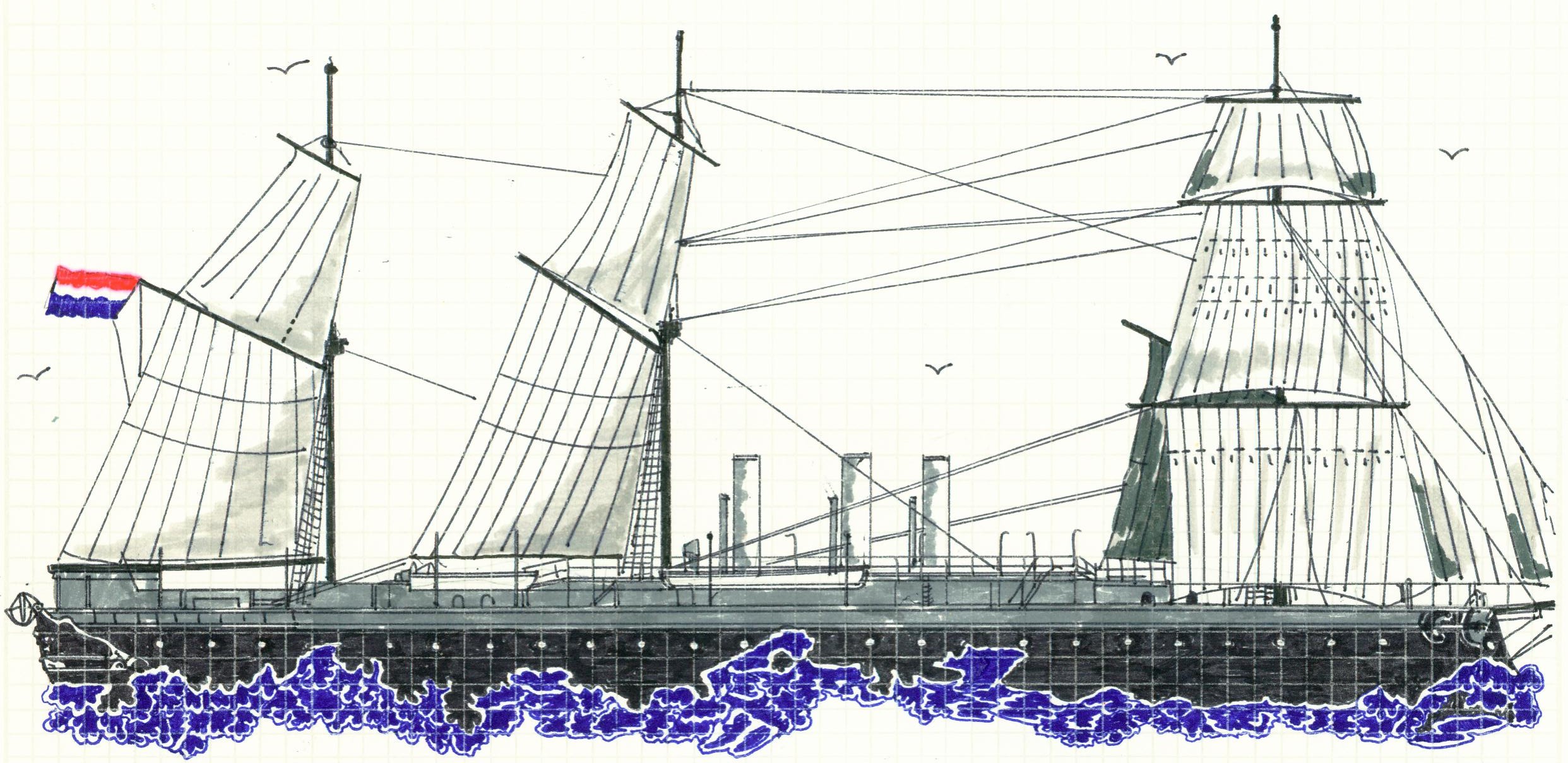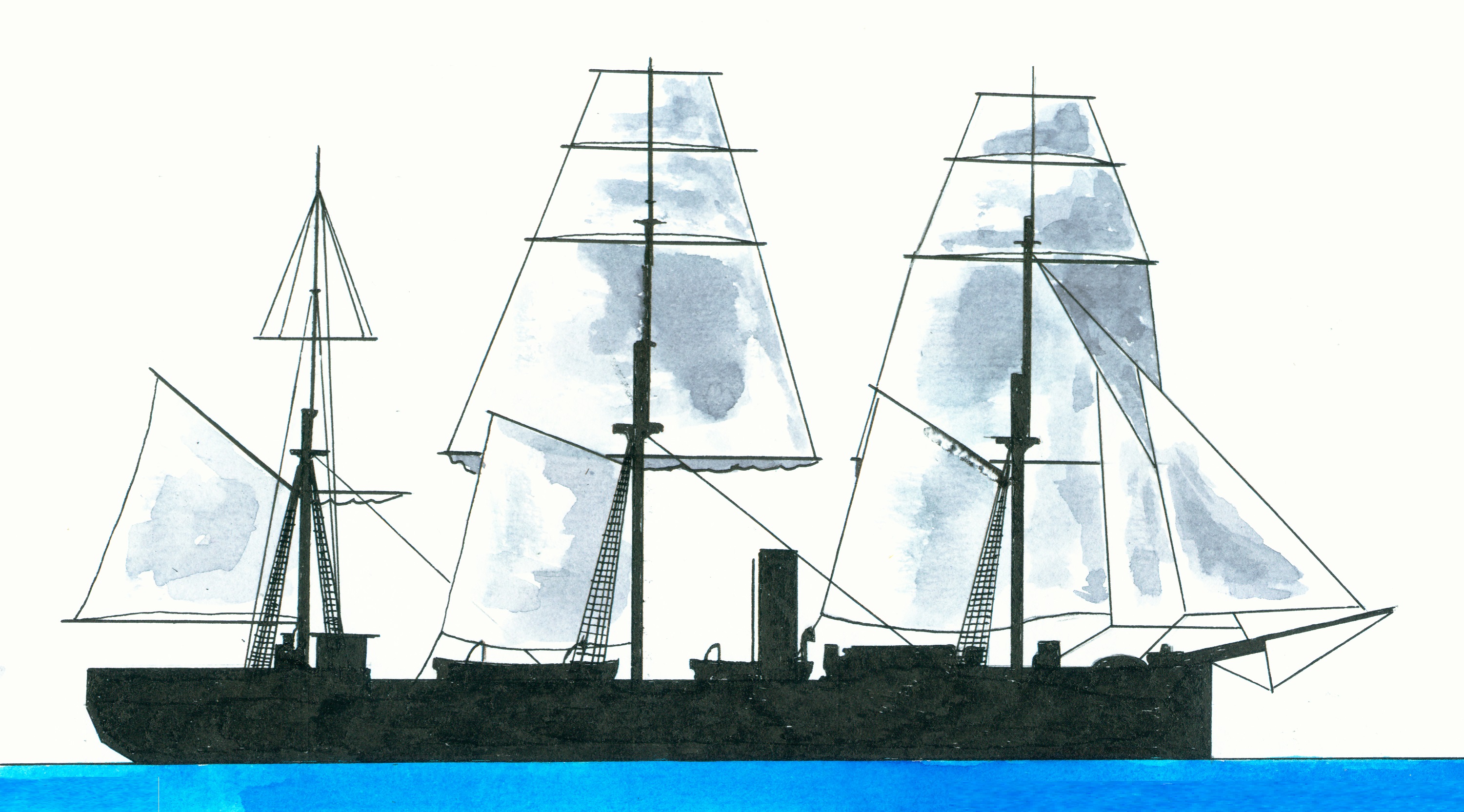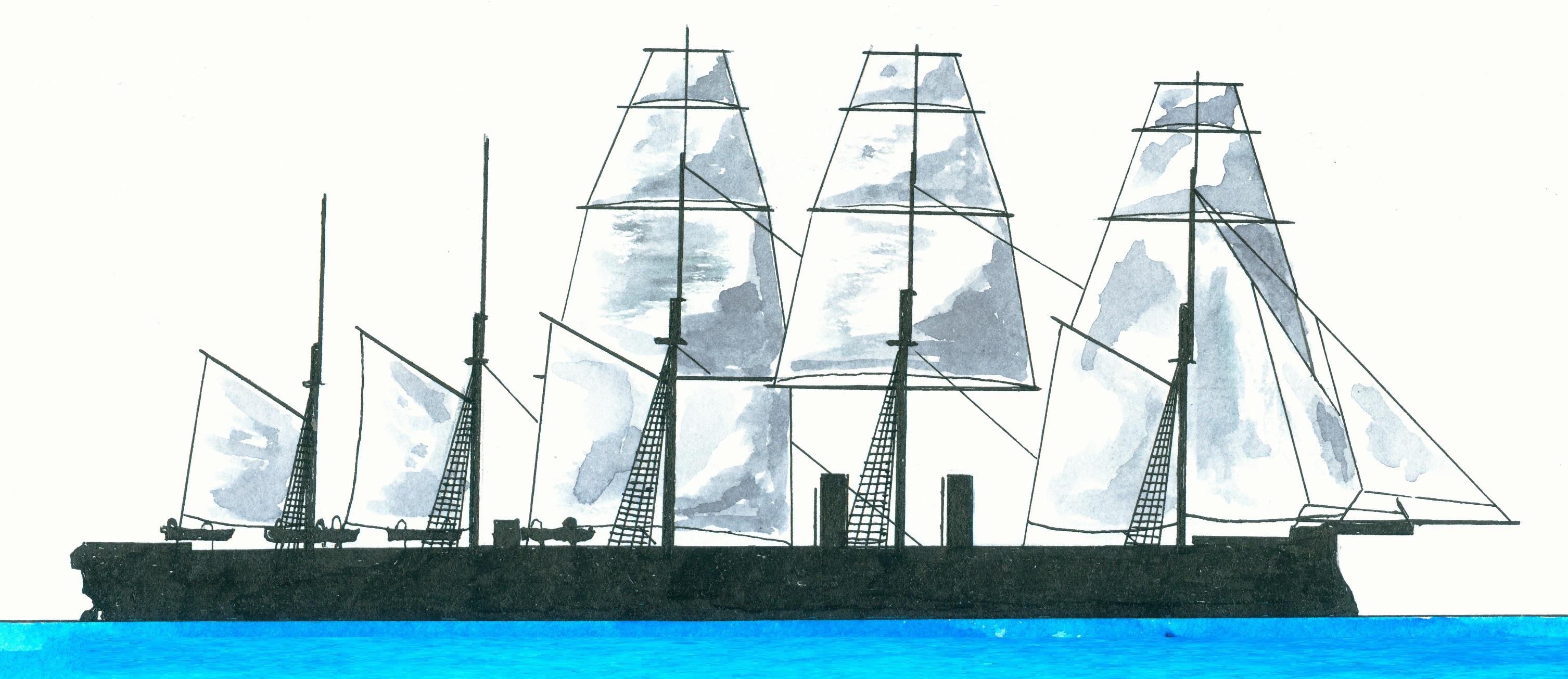Dutch Zr. Ms. Koning der Nederlanden
British Defence-class
British HMS Shannon
British Warrior-class
British Minotaur-class
The Dutch ram turret Zr. Ms. Koning der Nederland (1) captain W. Enslie (2) departed on 3 March 1878 towards the Dutch East Indies where she arrived at 6 May 1878 at Atjeh and added to the auxiliary squadron in the Dutch East Indies. She visited between 11-14 March Gibraltar. On 20 March arrived she at Malta. There were 3 armoured British warships HMS Defence (3), Shannon (4) and Black Prince (5), all part of the Channel Fleet. Later arrived also the HMS Minotaur (6). The Dutch commanding officer reported about the first ships of the Channel Fleet vice admiral Lord John Hay (7) that they had monstrous dimensions but still very fine shaped. The neatness of ship, rigging and crews was almost perfect. But except for the Shannon were the ships outdated by lacking sufficient armour and armament. He even wrote that according to his modest opinion in a real battle the Koning der Nederlanden had a lot of chance to be the winner. The British vice admiral visited the Koning der Nederlanden asking where the commanding officer was housed during a battle. When this was pointed out he reacted saying “You are in the right, for I am killed within the first five minutes on board of the Minotaur.”
Notes
1. This ram turret was designed by B.J. Tideman before the Noordzeekanaal was available, so it was a comprise between armour, artillery and horsepower. The result was a stern which was to 'full' and forced shaped. Ram turret, call sign GQMB, originally she was to be named Matador, on stocks at the naval yard at Amsterdam, Netherlands 28 November 1871, renamed Koning der Nederlanden on 24 February 1872 (other source claims even 24 April 1874), launched on 28 October 1874, commissioned on 16 February 1877 (other source claims 15 August 1876), transferred to the Indische Militaire Marine in 1894, decommissioned 1 April 1895, in August 1896 started the rebuilding at the naval yard at Surabaya, Dutch East Indies as a guard ship, commissioned on 1 December 1899, stricken in 1914 and became accommodation ship for the crew of the ships which were repaired and later for the submarine force, by Dutch navy personnel at Surabaya set on fire and sunk to prevent capture by the Japanese on 2 March 1942. Dimensions 81.78 (loadline between perpendiculars)-85.24 (over all) x 15.20 (over outside armour)x 5.83/8.93m, 5400 ton displacement , 2 engines with totally 7 boilers supplied 4630 ihp, 2 screws, speed 11,95 knots (on trial 26 July 1877), coal capacity 620 ton, armed with 4-28cm/11” guns , 4-12 cm/4.7” guns, 2-12cm/4.7” howitzers, 1-7cm/2.75” gun, 3-5cm/1.96” guns and 2-12cm/4.7” mortars. The sides were protected by 11,4/12,7cm (ends)-20,3cm/8” thick armour, turrets and turret bulwarks 22,9cm/9” and around the gun holes tot a maximum of 53,4cm/21” thick armour. The crew numbered 250 men. Fitted out with 3 masts. Trial off Texel 26 July 1877. Total costs while being prepared to depart for the first time to sea fl. 3.220,170,00.
2. Willem Enslie (30 June 1825 Brussels, Belgium-25 July 1898 Beek, Netherlands), ending his career in the rank of rear admiral on 1 August 1886.
3. Of the Defence-class armoured frigates, building ordered on 14 December 1859, laid down by Palmers, Jarrow, England on 14 December 1859, launched on 24 April 1861, completed on 12 February 1862, commissioned on 4 December 1861, converted into a floating workshop, renamed Indus in 1898 and sold at Devonport, England to be broken up in August 1935. Displacement 6.170 tons and as dimensions 85,3 x 16,5 x 8,0 metres or 280 x 54.2. x 26.2 feet. Speed 11 knots. Original armament consisted of 8-17,8cm/7”/110pd breech loading rifled guns, 4-12,7cm/5”/40pd breech loading guns and 10-20,1cm/7.9”/68pd smoothbore guns. Armour consisted of a 11,4cm/4.5” thick belt and 11,4cm/4.5” thick bulkheads.
4. The first armoured cruiser in the British Royal Navy. Laid down by Pembroke Dockyard on 29 August 1973, launched on 11 November 1875, commissioned on 17 September 1877 and sold to be broken up on 12 December 1899. With a displacement of 5.670 tons and as dimensions 79 x 16,5 x 6,78 metres or 260 x 54 x 22.3 feet. Speed 12,25 knots. Original armament consisted of 2-25,4cm/10” muzzle loading rifled guns and 7-22,9cm/7” muzzle-loading rifled guns. The armour consisted of a 15cm/6”-23cm/9” thick belt with 25,4cm/10”-33cm/13” teak beacking, a 3,8cm/1.5”-7,6cm/3” thick deck, 20cm/8”-23cm/9” thick bulkheads while the conning tower was protected by 23cm/9” thick armour.
5. Of the Warrior-class, laid down by Napier, Glasgow, Scotland on 12 October 1859, launched on 27 February 1861, completed on 12 September 1862, converted into training ship in 1899, renamed Emerald in 1903, renamed Impregnable II in 1910 and sold to be broken up in 1923. Armour consisted of 4.5”with 18” teak backing and 4.5” bulkheads. Armament consisted of 26-20,6cm/7.9”/68pd smoothbore muzzle-loading guns, 10-17,8cm/7”/110pd breech loading rifled guns and 4-12,1cm/4.75”/40pd breech loading rifled guns. Speed 13,6 knots. Displacement 9.284 tons and as dimensions 115,9 (between perpendiculars)-128 (over all)x 18,0 x 7,92 (maximum) metres or 420 x 58.4 x 26.10 feet..
6. Armoured frigate of the Minotaur-class, building ordered on 2 September 1861, laid down by Thames Ironworks and Shipbuilding Company, England on 12 September 1861m launched on 12 December 1863, completed on 1 June 1867, commissioned in April 1867, training ship since 1893, hulked in 1905 and sold to be broken up in 1922 which was executed in 1923. Displacement 10.798 tons and as dimensions and as dimensions 121,9 (between perpendiculars)-124,05 (0ver all) x 18,1 x 8,5 metres or 400-407 x 59.6 x 27.9 feet. Speed 14 knots. Armour consisted of a 11,4cm/4.5”-14cm/5.5 thick belt and 14cm/5.5” thick bulkheads. The rearmament consisted of 4-20,3cm/9” muzzle-loading rifled guns and 24-18cm/7” muzzle-loading rifled guns.
7. Lord John Hay (23 August 1827 Geneva Switzerland-4 May 1916 Fulmer, Buckinghamshire, England), served in the British Royal Navy between 1840-1892 ending in the rank of Admiral of the Fleet. Became in November 1877 commanding officer of the Channel fleet with as flagship the HMS Minotaur.





